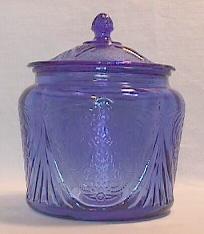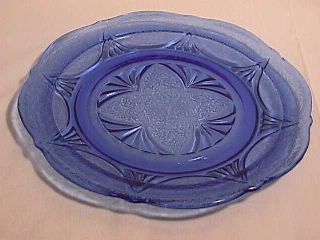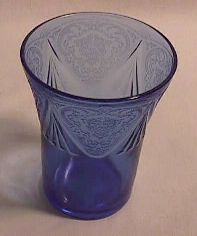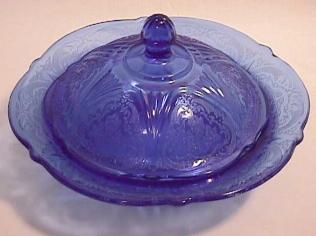

Royal Lace
Written by Rosemary Trietsch
Two words: Royal Lace. Of all the patterns of Depression glass that were ever produced, Royal Lace has captured (and broken) more hearts than just about any other. So strong is the allure that high prices and the scarcity of some pieces do not deter collectors in their search. The quest continues with more folks falling under its spell every day, making the competition fierce for even the common pieces. What is it about this pattern that drives so many wild? Let’s take a closer look and see.
The
‘Royal Lace Story’ begins in 1902 when Hazel Glass Company and Atlas Glass
and Metal Company merged to form Hazel-Atlas Glass Company of Wheeling West
Virginia. Originally specializing in glass containers, the company found its
niche in the glass world when it began producing kitchenware and drinking
tumblers. In fact, in 1928 one trade journal called it the “World’s Largest
Tumbler Factory” (HMW2). Color was first introduced in 1929, with green
kitchenware items taking immediate hold of the public’s eye. Pink and yellow
production began sometime around 1933, with Ritz Blue (cobalt) following soon
after. In the late 1930’s, Hazel Atlas tried to come up with a ruby glass, but
ended up with an amethyst color they called ‘Burgundy’.
Royal
Lace was produced from 1934 through 1941. The first colors made were green, pink
and crystal, though only crystal was produced throughout the life of the
pattern. The introduction of Ritz Blue and Royal Lace came about in 1936, and
their “How We Met” story is a classic. According to Weatherman, Hazel-Atlas
had the contract with General Mills to produce the Shirley Temple sets. When
General Mills suddenly decided to end the promotion, Hazel-Atlas was left with
vats of blue glass and no buyer in sight. Rather than waste it, the molten glass
was used in Royal Lace molds and it was an immediate success; so much so in fact
that green and pink production dwindled in favor of Ritz Blue.
Today, blue Royal Lace continues to be among the most sought after of Depression glass patterns, with green and pink closing the gap. Even crystal has a devoted following. But many folks who’ve fallen under the spell of this beautiful pattern have had to build their sets slowly, as prices of even the basic pieces can be prohibitive. A 5-piece place setting in blue (cup, saucer, 6 inch, 8-½ inch, and 9 7/8-inch plates) will easily run between $165 and $185 per setting. Pink and green are quickly catching up, selling in the $85 to $110 range, and crystal is downright cheap at $40. When you add berry bowls, sherbets, cream soup bowls and tumblers we’re talking about a major financial investment – let alone the time spent running around locating the stuff. You can take comfort in the fact that your collection will only go up in value, though if you haven’t completed your set yet, time is working against you as prices continue to climb.


(I want to take a minute to step off the subject of
Royal Lace and onto the subject of pricing Depression glass. If you looked in
Gene Florence’s book, the prices I quoted above are higher than the ‘book’
prices listed. Go back and read the beginning of the book where he tells you
that the prices listed are only a guide and that the regional distribution of
some patterns will cause variation. Now get a copy of the Daze and you’ll see
that the prices I quoted above are more in line with what things are actually
selling for in today’s market. Please
don’t misunderstand my intention: we need well done Depression glass books
like Florence’s to give us a foundation on which to work. The lists of
available pieces, measurements and oz capacities, and information about rare
items are vital to collectors. But
too many collectors – new and experienced alike - get into the mindset that
the price in the book is carved in stone and they refuse to pay more than
‘book’ no matter what the item is or how long they’ve been searching for
it. I often hear comments like, “I’ve been looking for this piece for 8
years and haven’t found one yet.” When I suggest that there are 4 of them on
the table across from me, I get the response, “Well, I haven’t found any for
book price”. Don’t you think that should say something to you?)
Royal
Lace has all the ‘typical’ serving pieces available. A round and an oval
vegetable bowl, an oval platter, salt & pepper shakers, a creamer and
covered sugar were all made and are relatively easy to find. (Note: the word
‘relatively’ is important!) The cover for the sugar bowl is hard to find in
any color. If you should come across a butter dish and cover remember that the
bottom is harder to find than the lid. Sherbets came in two styles: all glass,
or a glass insert in a metal holder. The glass/metal sherbets were probably part
of a set marketed by whatever company made the metal parts. The cookie jar
bottom was fitted with a metal lid that has a cutout for a ladle, placed on a
metal tray with 8 roly-poly tumblers and sold as a Cider set. They’ve also
been found with a closed lid for use as a tobacco jar, and with a metal lid that
has “Creamed Cottage Cheese, Golden State Co. Oakland, Glendale, and Los
Angeles” embossed on it (HMW2). With
all of these extra bottoms floating around, it’s easy to understand why glass
cookie jar lids are so difficult to find. In 1937, four different pieces were
made in Burgundy (Hazel-Atlas’ name for amethyst.) The sherbet in the metal
holder and cookie jar bottom (as part of the Cider set) were made and are
available. No glass cookie jar lid has ever turned up. The rolled edge console
bowl and candlesticks were also made and are very rare.
Hazel-Atlas produced the Royal Lace console set in three different styles. All three use the same 10-inch, three-legged console bowl teamed with candlesticks that are a miniature version of the bowl. In it’s simplest style the edges are left straight – as they came out of the mold. In another form, the edges of the bowl and candlesticks are ruffled, forming six scallops. The last and hardest to find style has the edges rolled over -somewhat similar to Hazel-Atlas’ mixing bowls that have the rolled over lip. These last two styles involve hand working of each piece while the glass was still hot, and so you’ll find variation from bowl to bowl. (As most of us will not get the opportunity to compare a few of these side by side, it’s sort of a moot point.)


Another item that seemed to capture Hazel-Atlas’
creative energies is the Royal Lace pitcher. There are 5 different pitchers with
the Royal lace pattern. The smallest holds 48 oz and has straight sides. The
next size is the 64-oz pitcher that came with or without an ice lip. With the
lip, it can hold 68 oz. The largest of the pitchers is the 86 oz shape, again
with or without an ice lip. When it has the lip, this pitcher can hold 96 oz.
Remember, the ice lips and spouts on pitchers were hand worked, so you’re
going to find variations in the ounce capacity from pitcher to pitcher.
Don’t think you’ve found an unknown pitcher just because it has an
ice lip and holds 70 oz. When handwork comes into play, variation is the norm.
As popular as it is, Royal Lace has only two reproductions to worry about: the cookie jar and the tumbler. Both are easy to spot. The 5-oz and 9 oz tumblers have both been reproduced. If you look at an old tumbler and a repro tumbler side by side, you’ll notice right away that the fake has too much glass in the bottom of the tumbler. Of course when you’re at a flea market, you won’t have the two side by side so remember: real Royal Lace tumblers have a pattern on the bottom while fakes do not. With cookie jars, if the top is with the bottom stop and take a second look. Tops are very rare. Turn the bottom over and look for the circular mold mark on the bottom. Fake cookie jars are smooth on the bottom. (If the bottom’s real, that’s a good sign as a fake top would probably be on a fake bottom.) When checking the top, turn it over and look on the underside. Old tops are smooth, fake tops have a dimple in the middle about the thickness of a pencil. When in doubt, trust your sense of touch: reproductions have that oily feel to them that comes from the silicone sprayed on the molds so the glass comes out easily. (Check my Cherry Blossom articles for a more detailed description of fake DG). Finally, use your common sense: if the person selling it has it marked “Rare Royal Lace cookie jar and lid, $39.75”, well, what more can I say.